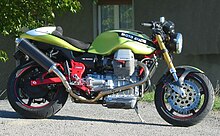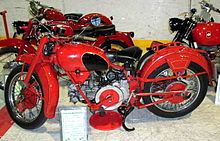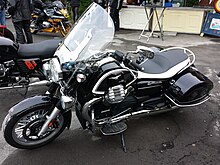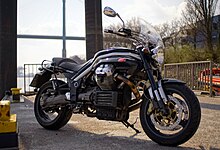Moto Guzzi
| Moto Guzzi
|
|
|---|---|
| legal form | Subsidiary of Piaggio |
| founding | 1921 |
| Seat | Mandello del Lario , Italy |
| management | Roberto Colaninno (pres.), Daniele Bandiera (AD) |
| Number of employees | about 300 |
| Branch | vehicle construction |
| Website | www.motoguzzi.com |
Moto Guzzi is an Italian manufacturer of motorcycles . Until the end of the 1980s, the product range included mopeds (Guzzino), scooters (Galletto), small motorcycles (Cardellino), three-wheelers ( Ercole , Mulo) and motorcycles with displacements between 125 and 1400 cm³. The company has been part of the Piaggio Group since 2004 and is managed by Tommaso Giocoladelli.
On January 1, 2017, 36,276 Moto Guzzi motorcycles were registered in Germany, which corresponds to a share of 0.8 percent.
technology
V2 engines
Moto Guzzi has been known for its V2 engines with a longitudinal crankshaft since the V7 model from 1966 . This design enables a low center of gravity, favors a cardan drive , since only one angular drive (on the rear wheel) is required, and compared to the boxer engine offers greater freedom from lean angles with less favorable mass balancing . The valve control of the V-2 was based on a camshaft with bumpers located below ; it was not until 1999 that overhead camshafts were used on some models .
Integral braking system
Since the 1970s, Moto Guzzi was the first manufacturer to introduce a composite brake known as an integral brake system into large models . The left front and rear brake discs are operated by the foot lever, while the right disc is operated by the hand lever. Since 2006 the manufacturer has offered an electronic ABS instead.
history
Pre-war period
On March 15, 1921, Army aviator Giorgio Parodi and his friend, aircraft technician Carlo Guzzi , founded “Moto Guzzi SpA” in Genoa with the financial support of Giorgo's father Emanuele Vittorio Parodi, with a plant in the Italian town of Mandello del Lario .
The first machine, the GP (Guzzi.Parodi), was built as a prototype with the help of the Mandello blacksmith in the basement of the Guzzi house. In a slimmed-down form, 17 motorcycles were built as the normal model in the year it was founded. Because of the close relationship between Parodi and Guzzi with airplanes and in memory of the third member of the Bund when the idea was born, Giovanni Ravelli, who crashed shortly after the First World War , the company logo is an eagle with outspread wings.
The brand became known through its participation in racing. The highlight was when Guido Mentasti won the first 500 cm³ European Championship in 1924 . In the European Championship race held in Monza , the C4V took second and fifth places in addition to first place.
In 1925, 1200 motorcycles were built in Mandello del Lario with over 300 employees. In 1928, Carlos brother Giuseppe Guzzi developed a future-oriented rear wheel suspension. It had a triangular swing arm with a set of springs that lay lengthways under the engine and was far superior to the suspensions customary at the time. Giuseppe Guzzi drove the “GT” offered in addition to the sports models as far as the Arctic Circle in Norway to prove its reliability. This earned the "GT" the nickname "Norge".
In 1934 Moto Guzzi was the largest motorcycle manufacturer in Italy.
In 1935 the Irishman Stanley Woods won the senior TT race at the Tourist Trophy on the Isle of Man on a 500 cm³ rear-wheel suspension "Bicilindrica" as the first pilot on a foreign machine . In the period that followed, all works racing teams switched to models with rear suspension. In the 250cc class, too, caused a sensation with the Italian star pilot of the time, Omobono Tenni . In 1937 Tenni won the quarter liter European title and was the first foreigner ever to win the Tourist Trophy with the TT race in the lightweight class.
post war period
After the Second World War , small, cheap transport devices for mass motorization were initially in demand. Moto Guzzi satisfied the rapidly increasing demand with the first two-stroke engine , the "Guzzino" 65, of which 50,000 were sold in the first three years. This motorcycle was further developed as the Moto Guzzi Cardellino in the 1950s. Giulio Cesare Carcano, Lino Tonti and Umberto Todero made themselves unforgettable as designers. In addition, larger motorcycles with horizontal single-cylinder four-stroke engines were also built again from 1949 :
- 1939 Moto Guzzi Airone , 250 cc
- 1949 Moto Guzzi Astore , 500 cc
- 1950 Moto Guzzi Galletto , scooter with 160, 175 and 192 cm³
- 1950 Moto Guzzi Falcone , 500 cc
- In 1955 there was the Moto Guzzi V8 , a racing machine with a V8 engine
The late 1940s and early 1950s were a very successful period for the company thanks to the racing successes in the European motorcycle championship and the newly created world championship . Between 1947 and 1948, the manufacturer won four of the six European championship titles it had won. In 1949 , works driver Bruno Ruffo became the first 250 cc world champion in history, and in 1951 he repeated winning the title in this category. In the 1953 season , Fergus Anderson won the first driver's title in the 350cc class for Moto Guzzi, which he successfully defended the following season . By 1957 , the pilots Bill Lomas and Keith Campbell followed three more titles. Moto Guzzi then withdrew from racing, as the entire Italian motorcycle market had fallen into an existential crisis at this time. Cars were in demand, and motorbike sales fell rapidly. The 1957 world championship title was the last great racing success for Moto Guzzi. In 1955 Giorgio Parodi died, in 1964 Carlo Guzzi, who was never a shareholder in Moto Guzzi, but always only a “technical advisor”.
On February 1, 1967, a new company was founded under the name SEIMM . There were new Moto Guzzi models again:
- 1967 Moto Guzzi V7 with 700 cm³, 750 cm³ and 850 cm³ V2 engine
- 1969 Moto Guzzi Nuovo Falcone with a 500 cc single cylinder engine
- In 1973 the De Tomaso Industries Inc. group bought the company. De Tomaso takes over the construction management himself.
- 1974 Integral braking system for their motorcycles, similar to the Honda CBS presented twelve years later
The technical basis for today's models was laid at the end of the 1950s. At that time the “unemployed” racing department developed the 90 ° V two-cylinder for installation in the new small Fiat . In the mid-1960s, this engine concept was reactivated for a tender for an Italian government motorcycle, adapted to the requirements of a motorcycle and combined with a cardan drive. The characteristic feature of the Moto Guzzi motorcycles since then has been the V-shaped cylinder heads of the longitudinal engine that protrude laterally from the profile.
The two product lines differentiate between touring machines , especially with the “California” model, and sporty motorcycles such as the “Le Mans”, “Daytona” and “Centauro”.
Aprilia and Piaggio
Moto Guzzi, however, repeatedly had major economic difficulties until Ivano Beggio, as the owner of Aprilia, decided in 2000 to buy Moto Guzzi as well as Laverda and to renovate it comprehensively. His first development is the “Rosso Mandello”, which is an immediate success.
Between December 28 and 30, 2004, the Piaggio Group took over the Aprilia Group, including Moto Guzzi. The Italian motorcycle pool was born, Moto Guzzi was now part of a world-leading group with a turnover of 1.5 billion euros and a market share of 24 percent in Europe.
On March 3, 2005, 47-year-old Daniele Bandiera was hired to be responsible for the restart of Moto Guzzi. On March 24th, the new Breva 1100 model was officially presented in Milan , with some technical innovations in the cardan construction and the tried and tested air-cooled V-engine, which now also meets the Euro 3 emissions standard . Production continues at the Mandello plant, which has now been modernized. The plant needs around 13,000 motorcycles sold each year to survive. Moto Guzzi was well on the way to achieving this: more than 10,000 motorcycles were built in 2006, after 4,000 in 2004 and 7,000 in 2005. The new engine production that went into operation in 2006 also contributed to this, and it was the first at the celebrations for the company's 85th anniversary could be visited.
Picture gallery
Moto Guzzi from Peppone
Models and engines
Current models
Moto Guzzi uses three different air / oil-cooled V-engines with two cylinders and offers the following models.
| model | Type | Displacement | power | introduction | Model variants and comments |
|---|---|---|---|---|---|
| California 1400 | Cruiser | 1380 cc | 96 hp | air / oil cooled motor
|
|
| MGX-21 | Cruiser | 1380 cc | 96 hp | air / oil cooled motor | |
| V9 | Naked bike | 853 cc | 55 hp | 2016 | air-cooled engine
|
| V7 III | Naked bike | 744 cc | 52 hp | 2017 | air-cooled engine
|
| V85 TT | Travel enduro | 853 cc | 80 hp | 2019 | air-cooled engine |
The following models are no longer produced.
Single cylinder engines
Unless otherwise stated, it is an air-cooled, single-cylinder , four-stroke engine .
| model | Displacement | power | introduction | End of production | Model variants and comments |
|---|---|---|---|---|---|
| Normal | 498 cc | 9 hp | 1921 | 1924 | |
| Sports | 498 cc | 13 hp | 1923 | 1939 |
|
| GT | 498 cc | 13 hp | 1928 | 1934 |
|
| V series | 498 cc | 19-26 hp | 1933 | 1948 |
|
| S series | 498 cc | 13 hp | 1934 | 1940 |
|
| Alce | 498 cc | - | 1939 | 1945 | Military motorcycle |
| Superalce | 498 cc | - | 1943 | 1955 | |
| Dondolino | 498 cc | - | 1946 | 1951 | Racing motorcycle |
| Astore | 498 cc | 19 hp | 1948 | 1953 | |
| Falcone | 498 cc | 23 hp | 1950 | 1976 | |
| Nuovo Falcone | 498 cc | 26 hp | 1971 | 1976 | |
| P series | 174-247 cc | 7-9.5 hp | 1932 | 1940 |
|
| Airone | 246 cc | 9.5-13.5 hp | 1939 | 1957 |
|
| Motoleggera 65 | 64 cc | 2 hp | 1946 | 1954 | Light motorcycle, 2-stroke engine |
| Galletto | 160-192 cc | 6-7.5 hp | 1950 | 1966 |
Scooter
|
| Zigolo | 98 cc | 4 hp | 1953 | 1966 | |
| Cardellino | 73 cc | - | 1954 | 1962 | |
| GT 175 Gran Turismo | 175 cc | - | 1959 | 1965 | |
| Lodola Regolarita | 175 cc | - | 1959 | 1965 | |
| Stornello 125 Sport | 123 cc | 7 hp | 1961 | 1967 |
Multi-cylinder engines (without V2)
| Engine / model | Displacement | power | introduction | End of production | Model variants and comments |
|---|---|---|---|---|---|
| Tre Cilindri | 495 cc | - | 1932 | 1933 | Super sports car with a three-cylinder 4-stroke engine |
| V8 | 499 cc | 78 hp | 1955 | 1957 | Racing motorcycle with V8 4-stroke engine |
| 254 | 231 cc | 28 hp | 1972 | 1979 | R4 4-stroke engine |
| 250TS | 231 cc | 30 hp | 1974 | 1982 | R2 2-stroke engine |
| 350 GTS | 345 cc | 31 hp | 1974 | 1975 | R4 4-stroke engine |
| 400 GTS | 397 cc | 40 hp | 1974 | 1979 | R4 4-stroke engine |
Two-cylinder V-engines
Upper class
| Engine / model | Displacement | power | introduction | End of production | Model variants and comments |
|---|---|---|---|---|---|
| V7 | 704 cc | 40 hp | 1967 | 1969 | |
| V7 special | 758 cc | 49 hp | 1969 | 1976 |
|
| V7 sport | 748 cc | 52 hp | 1971 | 1974 | |
| V7 850 GT | 844 cc | 51 hp | 1972 | 1974 |
|
| 850 | 844 cc | 55-81 hp | 1975 | 1987 |
|
| 1000 | 949 cc | 67-85 hp | 1975 | 1997 |
|
| Daytona | 992 cc | 102 hp | 1992 | 1999 |
|
| V10 | 992 cc | 95 hp | 1996 | 2001 |
|
| 1100 | 1064 cc | 69-90 hp | 1994 | 2001. |
|
| V11 | 1064 cc | 86-91 hp | 1999 | 2014 |
|
| 1200 | 1151 cc | 95 hp | 2005 | 2014 |
|
| V12 | 1151 cc | 2009 | 2009 |
|
|
| 1400 | 1380 cc | 96 hp | 2013 | air / oil cooled motor
|
|
| 1400 | 1380 cc | 96 hp | 2015 | air / oil cooled motor
|
|
| 1200 8V | 1151 cc | 102-106 PS | 2007 | 2016 | air / oil cooled engine with 4 valves per cylinder
|
| MGS-01 Corsa | 1225 cc | 128 hp | 2006 | 2011 | Super athlete |
Middle class
| Engine / model | Displacement | power | introduction | End of production | Model variants and comments |
|---|---|---|---|---|---|
| V35 | 346 cc | 34 hp | 1977 | 1990 |
|
| V50 | 490 cc | 45 hp | 1977 | 1986 |
|
| V65 | 643 cc | 52 hp | 1982 | 1994 |
|
| 750 | 744 cc | 45-58 hp | 1990 | 2010 |
|
| V7 Classic | 744 cc | 50 hp | 2007 | 2014 |
|
| 850 | 877 cc | 71-95 hp | 2006 | 2010 |
|
| Bellagio | 935 cc | 75 hp | 2007 | 2014 | Naked bike |
| V7 II | 744 cc | 48 hp | 2015 | ||
| V9 | 850 cc | 55 hp | 2016 |
|
|
| V7 III | 744 cc | 48 hp | 2017 |
|
See also list of Moto Guzzi motorcycles .
Motorcycle racing
Motorcycle world championship
In total, Moto Guzzi was able to win eight rider world championship titles in the motorcycle world championship .
![]() Bruno Ruffo (2)
Bruno Ruffo (2)
![]() Fergus Anderson (2)
Fergus Anderson (2)
![]() Bill Lomas (2)
Bill Lomas (2)
- World champion in the 250 cm³ class: 1952
![]() Keith Campbell (1)
Keith Campbell (1)
- World champion in the 350 cm³ class: 1957
European motorcycle championship
The manufacturer won seven rider titles in the European motorcycle championship .
![]() Omobono Tenni (2)
Omobono Tenni (2)
![]() Guido Mentasti (1)
Guido Mentasti (1)
- European champion in the 500 cm³ class: 1924
![]() Riccardo Brusi (1)
Riccardo Brusi (1)
- European champion in the 250 cm³ class: 1932
![]() Bruno Francisci (1)
Bruno Francisci (1)
- European champion in the 250 cm³ class: 1947
![]() Maurice Cann (1)
Maurice Cann (1)
- European champion in the 250 cm³ class: 1948
- European champion in the 500 cm³ class: 1948
Trivia
In the Don Camillo and Peppone novels by the Italian author Giovanni Guareschi , one of the two main characters, the communist mayor “Peppone” Bottazzi, drives a Moto Guzzi.
literature
- Jan Leek: Moto Guzzi - motorcycles since 1945. Type compass. Motorbuch, Stuttgart 2004, ISBN 3-613-02431-4 .
- Alessandro Pasi, translated and edited by Udo Stünkel: Moto Guzzi - The story of the eagles from Mandello . Delius Klasing Verlag , Bielefeld 2009, ISBN 978-3-7688-5294-4 .
- Jan Leek, Wolfgang Zeyen: Moto Guzzi motorcycles since 1921. Motorbuch-Verlag, Stuttgart 2008, ISBN 978-3-613-02731-2 .
- Wolfgang Zeyen: Motorbikes that made stories- Moto Guzzi- The large V-two-cylinder Motorbuch-Verlag, Stuttgart 1994, ISBN 3-613-01383-5 .
Web links
- Official German website
- Official Swiss website
- Official Austrian website
- Link catalog on Moto Guzzi at curlie.org (formerly DMOZ )
- Motorcycle Encyclopedia
- Moto Guzzi 850 Le Mans
Individual evidence
- ↑ Vehicle registrations (FZ) - Stock of passenger cars and motorcycles by brand or manufacturer January 1, 2016. (PDF) In: kba.de. Federal Motor Transport Authority, January 1, 2016, p. 9 , accessed on January 14, 2017 .
- ↑ Till Schauen: Fascination Technology - Pre-war high-tech at its best: Moto Guzzi C4V. www.mgcn.nl, August 8, 2001, accessed May 4, 2010 .
- ↑ Vincent Glon: L'Histoire de la course moto - Palmarès des Championnats d'Europe (1924-1937 et 1947-1948). racingmemo.free.fr, accessed May 4, 2010 (French).
- ↑ Vincent Glon: L'Histoire de la course moto; 5th partie: Les Grand Prix d'Europe. (1924-1937); 1924. racingmemo.free, accessed May 4, 2010 (French).
- ↑ Moto Guzzi Germany website , accessed on May 21, 2018.
- ↑ Auto Evolution Moto Guzzi , accessed on April 9, 2015.
- ↑ Moto Guzzi V7 Special data sheet , accessed on April 9, 2015.
















